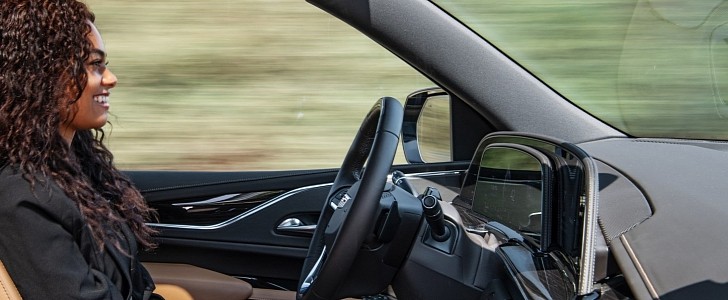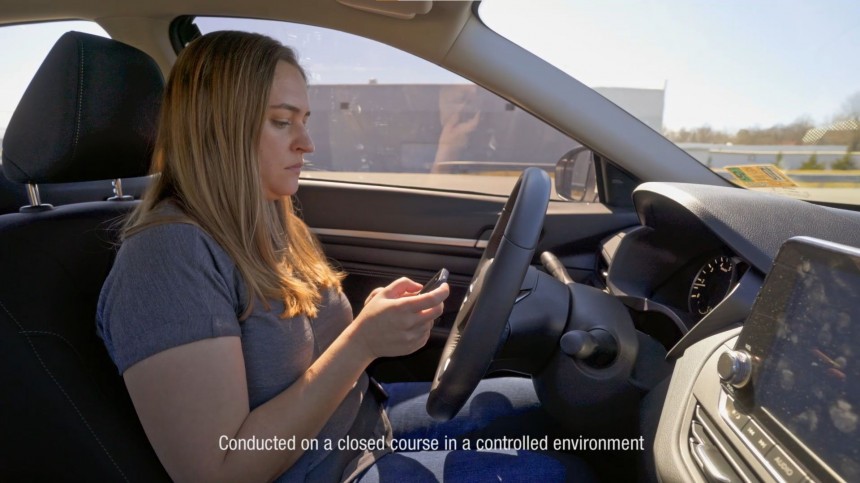Are you familiar with driver monitoring systems? You know, those technologies developed by automakers to ensure drivers have not fallen asleep or focusing their attention on something other than driving? A test made by AAA found that neither camera-based nor steering wheel-based systems is without flaw.
As explained above, automakers currently employ two types of systems to ensure that drivers are attentive to the road. One type of system gauges steering inputs or lack of input if we think about it, while the other has a special camera above the gauge cluster to monitor the motion of the driver's eyes.
Triple-A researchers tested four vehicles, two with each type of system. The camera-monitoring systems were represented by a 2021 Subaru Forester with EyeSight and Driver Focus, along with a 2021 Cadillac Escalade with Super Cruise. Meanwhile, in the steering-wheel-monitoring camp, AAA tested a 2020 Tesla Model 3 with Autopilot and a 2020 Hyundai Santa Fe with Highway Driving Assist.
The vehicles mentioned above employ what the Society of Automotive Engineers (SAE) describes as Level 2 autonomy, which is effectively semi-autonomy, as the functions that are available on some vehicles with the technology require the driver to pay attention to the road and just involve helping the driver by maintaining the vehicle in its lane in certain conditions, applying the brakes if needed and maintaining a pre-set speed.
All the above involve electronic control of steering, brakes, and throttle, which must never be confused with autonomous driving, as the person behind the wheel must be licensed to drive said vehicle, as well as able to drive, since they are still legally and technically in control of the vehicle.
With that aspect clarified, the systems that the AAA tested were there to ensure that people are not attempting to trick the vehicle into "driving itself," as well as if they are effective in preventing a crash.
The camera-based system was faster at discovering lack of driver attention, as it took the technology less than ten seconds on average for both the Cadillac and the Subaru to notice that the driver has let go of the steering wheel or is looking away from the road (usually by glancing down or having eyes closed).
The effectiveness of camera-based systems is still good, as they are infrared-based units, which means they work at night. From personal experience, using polarized sunglasses or certain types of sunglasses might affect their operation, as they might not “see” a driver's eyes if the lenses are too dark.
Do not quote us on this, as we did not get to try it with every system on the market and every possible type of sunglasses, but if your smartphone has a face-unlock function that does not work through your sunglasses, those sunglasses might not be compatible with the cameras in your vehicle.
However, as AAA notes, when driving at 65 mph (ca. 104 kph), ten seconds (on average) means that the vehicle has traveled almost a mile (ca. 1.6 km) with the driver not having their eyes on the road. The concerning part? The camera-based system performed better than the steering-wheel-monitoring tech.
As for the steering wheel monitoring system, the warning comes in, on average, after nearly one minute. At 65 miles per hour, it means about 6 miles (9.66 km) without steering input. This type of system is easier to trick, which means that a driver could go even further without genuinely controlling the wheel. Other tests have shown how easy it is to trick these systems.
According to AAA, the warning should come sooner. But how soon would it be too soon? Since these systems are not mandatory and can be disabled by the driver, making a system too annoying could make drivers switch it off, rendering it useless and even more dangerous than the current variant.
Mind you, the testing period for the monitoring systems is not continuous, it was just a ten-minute window, and the driver assistance systems could be reactivated once the lane assist system was shut off after discovering driver inattentiveness.
Some models do shut off systems like these if they detect attempted abuse, but they can be activated back up after a given period.
Regardless, attempting to trick these systems is silly, as the person behind the wheel is fully responsible for what happens when driving, so you are only tricking yourself and risking the lives of everybody else on the road when doing this.
Triple-A researchers tested four vehicles, two with each type of system. The camera-monitoring systems were represented by a 2021 Subaru Forester with EyeSight and Driver Focus, along with a 2021 Cadillac Escalade with Super Cruise. Meanwhile, in the steering-wheel-monitoring camp, AAA tested a 2020 Tesla Model 3 with Autopilot and a 2020 Hyundai Santa Fe with Highway Driving Assist.
The vehicles mentioned above employ what the Society of Automotive Engineers (SAE) describes as Level 2 autonomy, which is effectively semi-autonomy, as the functions that are available on some vehicles with the technology require the driver to pay attention to the road and just involve helping the driver by maintaining the vehicle in its lane in certain conditions, applying the brakes if needed and maintaining a pre-set speed.
All the above involve electronic control of steering, brakes, and throttle, which must never be confused with autonomous driving, as the person behind the wheel must be licensed to drive said vehicle, as well as able to drive, since they are still legally and technically in control of the vehicle.
With that aspect clarified, the systems that the AAA tested were there to ensure that people are not attempting to trick the vehicle into "driving itself," as well as if they are effective in preventing a crash.
The camera-based system was faster at discovering lack of driver attention, as it took the technology less than ten seconds on average for both the Cadillac and the Subaru to notice that the driver has let go of the steering wheel or is looking away from the road (usually by glancing down or having eyes closed).
Do not quote us on this, as we did not get to try it with every system on the market and every possible type of sunglasses, but if your smartphone has a face-unlock function that does not work through your sunglasses, those sunglasses might not be compatible with the cameras in your vehicle.
However, as AAA notes, when driving at 65 mph (ca. 104 kph), ten seconds (on average) means that the vehicle has traveled almost a mile (ca. 1.6 km) with the driver not having their eyes on the road. The concerning part? The camera-based system performed better than the steering-wheel-monitoring tech.
As for the steering wheel monitoring system, the warning comes in, on average, after nearly one minute. At 65 miles per hour, it means about 6 miles (9.66 km) without steering input. This type of system is easier to trick, which means that a driver could go even further without genuinely controlling the wheel. Other tests have shown how easy it is to trick these systems.
According to AAA, the warning should come sooner. But how soon would it be too soon? Since these systems are not mandatory and can be disabled by the driver, making a system too annoying could make drivers switch it off, rendering it useless and even more dangerous than the current variant.
Mind you, the testing period for the monitoring systems is not continuous, it was just a ten-minute window, and the driver assistance systems could be reactivated once the lane assist system was shut off after discovering driver inattentiveness.
Some models do shut off systems like these if they detect attempted abuse, but they can be activated back up after a given period.
Regardless, attempting to trick these systems is silly, as the person behind the wheel is fully responsible for what happens when driving, so you are only tricking yourself and risking the lives of everybody else on the road when doing this.
















